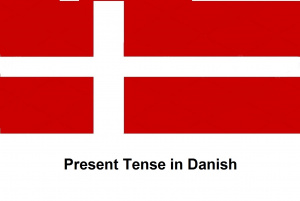Difference between revisions of "Language/Danish/Grammar/Present-Tense"
| Line 4: | Line 4: | ||
One of the fundamental aspects of learning a new language is understanding its grammar rules. In Danish, the present tense is used to describe actions happening now or habitual actions. This lesson will provide you with an overview of the Danish present tense, its formation, and examples of its usage. | One of the fundamental aspects of learning a new language is understanding its grammar rules. In Danish, the present tense is used to describe actions happening now or habitual actions. This lesson will provide you with an overview of the Danish present tense, its formation, and examples of its usage. | ||
__TOC__ | __TOC__ | ||
* Upon finishing this course material, you may want to delve into these connected themes: [[Language/Danish/Grammar/Danish-Alphabet|Danish Grammar → Introduction to Danish Alphabet and ...]], [[Language/Danish/Grammar/Conditional-Mood|Conditional Mood]], [[Language/Danish/Grammar/Comparatives-and-Superlatives|Comparatives and Superlatives]] & [[Language/Danish/Grammar/Regular-Verbs|Regular Verbs]]. | * Upon finishing this course material, you may want to delve into these connected themes: [[Language/Danish/Grammar/Danish-Alphabet|Danish Grammar → Introduction to Danish Alphabet and ...]], [[Language/Danish/Grammar/Conditional-Mood|Conditional Mood]], [[Language/Danish/Grammar/Comparatives-and-Superlatives|Comparatives and Superlatives]] & [[Language/Danish/Grammar/Regular-Verbs|Regular Verbs]]. | ||
Revision as of 15:07, 7 May 2023
One of the fundamental aspects of learning a new language is understanding its grammar rules. In Danish, the present tense is used to describe actions happening now or habitual actions. This lesson will provide you with an overview of the Danish present tense, its formation, and examples of its usage.
- Upon finishing this course material, you may want to delve into these connected themes: Danish Grammar → Introduction to Danish Alphabet and ..., Conditional Mood, Comparatives and Superlatives & Regular Verbs.
In Danish, the conjugation of verbs is the same across all pronouns. The infinitive verbs always end in -e, and are always preceded by the phrase "at". For example: "at gå", meaning "to go" or "to walk". To form the present tense, you have to add -r to the verb, and replace the "at" with the correct pronoun depending on your subject.
Personal Pronouns
In Danish, there are several personal pronouns that are used to refer to different persons or groups.
Here are the personal pronouns in Danish with their English translations:
| ENGLISH | DANISH |
|---|---|
| I | JEG |
| YOU | DU |
| HE | HAN |
| SHE | HUN |
| WE | VI |
| YOU (PLURAL) | I |
| THEY | DE |
Regular Verbs
In Danish, regular verbs are divided into two groups based on their infinitive forms:
a. Group 1: Verbs ending in -e
To form the present tense of verbs in this group, simply add -r to the infinitive form of the verb.
Examples:
- at arbejde (to work) -> arbejder (working)
- at spise (to eat) -> spiser (eating)
b. Group 2: Verbs ending in a consonant
For verbs in this group, add -er to the infinitive form to create the present tense.
Examples:
- at skrive (to write) -> skriver (writing)
- at løbe (to run) -> løber (running)
Irregular Verbs
While Danish has many regular verbs, some verbs are irregular and follow different patterns in the present tense. Here are some common irregular verbs:
- at være (to be) -> er (am/are/is)
- at have (to have) -> har (have/has)
at gå (to go) -> går (go/going)
Using the example of "at gå" (to go):
| ENGLISH | DANISH |
|---|---|
| I GO | JEG GÅR |
| YOU GO | DU GÅR |
| HE GOES | HAN GÅR |
| SHE GOES | HUN GÅR |
| WE GO | VI GÅR |
| YOU (PLURAL) GO | I GÅR |
| THEY GO | DE GÅR |
- at se (to see) -> ser (see/seeing)
Examples of Present Tense Usage
a. Describing current actions:
- Han arbejder i køkkenet. (He is working in the kitchen.)
- Vi spiser morgenmad. (We are eating breakfast.)
b. Describing habitual actions:
- Hun løber hver dag. (She runs every day.)
- De ser fjernsyn om aftenen. (They watch television in the evening.)
Negation in the Present Tense
To form a negative sentence in the present tense, use the word "ikke" (not) after the verb.
Examples:
- Han arbejder ikke i dag. (He is not working today.)
- Vi spiser ikke kød. (We do not eat meat.)
Other Lessons
- The Genitive Case in Danish
- The Nominative Case in Danish
- Questions
- Adjectives
- Plurals
- The Accusative Case in Danish
- The Locative Case in Danish
- How to use “can” in Danish
- How to use “to be” with names and places
